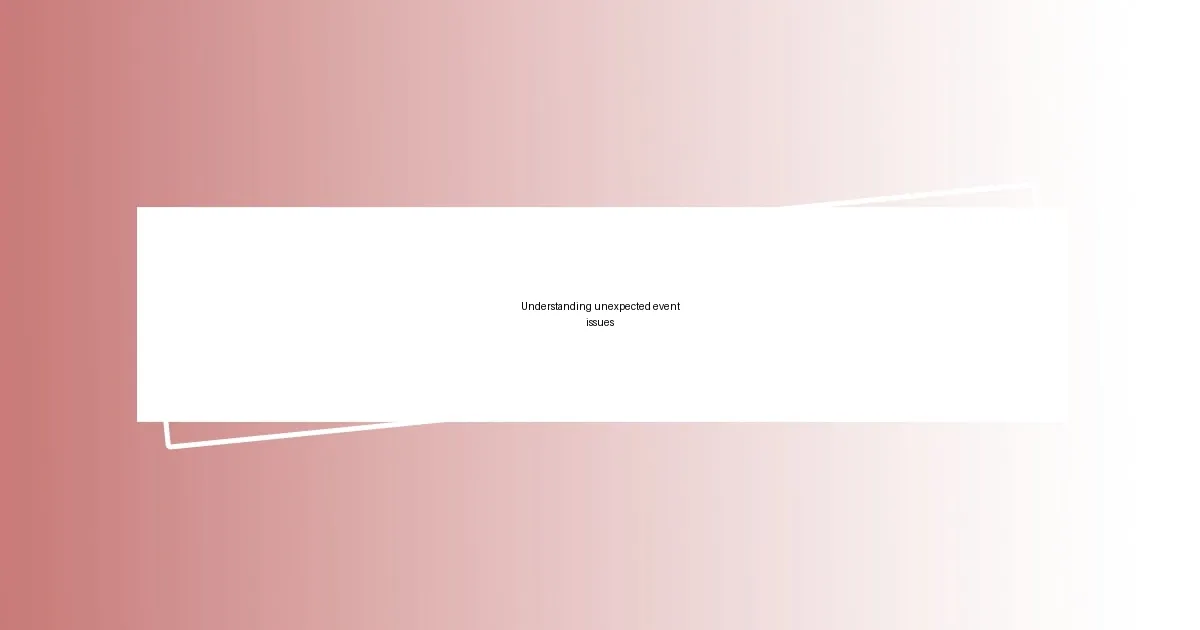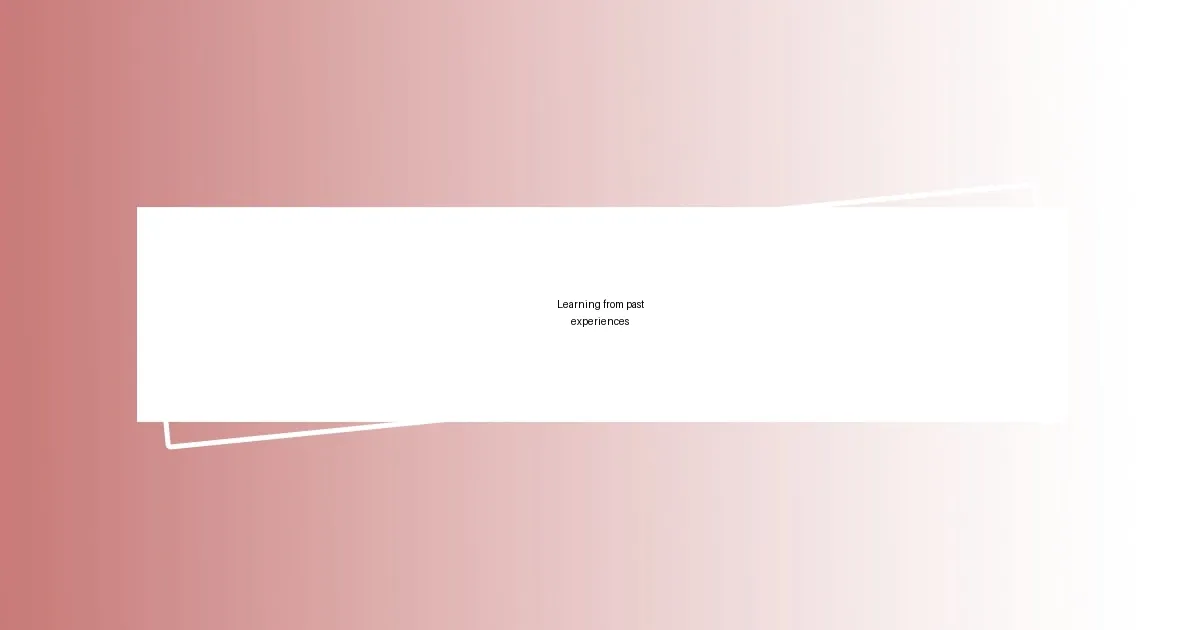Key takeaways:
- Embrace uncertainty as part of event planning and use chaos to reveal problem-solving skills.
- Preparation is key: proactive scenario planning, flexible team roles, and backup plans can transform potential disasters into successful experiences.
- Effective communication during unexpected issues fosters trust and engagement, reducing panic and confusion.
- Learn from past experiences to enhance adaptability, emotional responses, and overall leadership in future challenges.

Understanding unexpected event issues
Unexpected event issues can twist your plans in ways you never imagined. I remember planning a straightforward outdoor event, only to be met with a sudden downpour. It made me realize that no matter how much we prepare, nature has its own agenda. Have you ever found yourself scrambling to adapt when faced with the unexpected?
Understanding these issues means accepting that uncertainty is part of any event. I’ve come to appreciate the moments of chaos; they often unveil my true problem-solving skills. When things don’t go as planned, I ask myself, “What’s the worst that could happen?” This question helps to ground me, shifting my focus from panic to potential solutions.
Unexpected challenges can also reveal opportunities for growth, both personally and professionally. For instance, during one event, a surprise cancellation opened the door for a last-minute speaker who turned out to be a massive hit. This taught me that sometimes, the best outcomes come from the moments we least anticipate. How about you? Have you encountered a hidden gem amongst the chaos?

Preparing for unexpected events
Preparing for unexpected events requires a proactive mindset. I always try to envision various scenarios before an event, like a proactive chess player anticipating their opponent’s moves. For example, during an indoor event, we had a power outage just as our keynote speaker was about to begin. Thankfully, we had flashlights and portable speakers ready, which turned what could have been a disaster into an intimate session filled with stories and connection.
I’ve learned that creating a flexible plan is crucial. This means identifying key roles for team members and having clear communication channels in place. When my team faced unexpected technical issues at a recent conference, it was our rapid response system—everyone knew who to contact and what their role was—that saved us time and reduced stress. It felt almost like a well-rehearsed dance, where everyone knew their moves, allowing us to adapt fluidly in front of our audience.
The importance of a backup plan cannot be overstated. For example, when we planned an outdoor wedding, we had a tent ready just in case the weather turned. Sure enough, it rained a little, but with the tent in place, the celebration continued seamlessly. In that moment, I felt a rush of relief—preparation truly pays off, transforming potential anxiety into joy.
| Preparation Strategy | Example |
|---|---|
| Proactive Scenario Planning | Envisioning potential challenges before they arise |
| Flexible Team Roles | Assigning specific tasks to team members for quick adaptation |
| Backup Plans | Having alternative solutions ready to implement, like tents or equipment |

Assessing the impact of issues
Assessing the impact of unexpected issues is a critical step in navigating any event. Personally, I’ve found that taking a moment to evaluate the fallout can transform chaos into clarity. For instance, during a corporate retreat, an unforeseen transportation strike forced me to reconsider our entire itinerary. By quickly gathering feedback from participants about their priorities, I was able to pivot and create a more engaging experience, turning the challenge into an unexpected team-building opportunity.
Here are some aspects I prioritize when assessing impact:
- Identify Key Stakeholders: Who will be affected by the issue? Understanding this helps gauge the broader implications.
- Evaluate Immediate Effects: What are the most pressing issues that need resolution?
- Consider Long-term Consequences: How might these issues affect future events or relationships?
- Gather Feedback: Engaging with your team or participants can unveil insights on how the issue is perceived.
- Reflect on Learnings: Each situation teaches something valuable. I keep a journal to document insights for future reference.
In my experience, this process not only stabilizes the current situation but also builds a foundation for resilience in the face of future challenges.

Developing a response strategy
Developing a response strategy is all about embracing the unexpected with confidence and clarity. I recall a networking event where the fire alarm went off unexpectedly. Instead of panicking, we quickly assembled our team and communicated clearly with attendees, guiding everyone to calmly exit the venue. This approach not only kept us organized but also reassured everyone that we had the situation under control. Isn’t it comforting to know that a solid strategy can turn chaos into composure?
When devising a response strategy, I often emphasize the importance of clear communication. In a recent team meeting, we faced an unexpected last-minute speaker cancellation. With a straightforward plan outlining who would communicate updates, we kept everyone in the loop, and that minimized confusion. I felt a surge of pride as I watched my team adapt, showing resilience and creativity in the face of uncertainty. Have you ever experienced that moment when your strategy just clicks into place?
Lastly, it’s essential to build flexibility into your plan. I’ve learned that over-planning can sometimes stifle spontaneity. During a product launch, we anticipated every detail, yet things didn’t unfold as expected. By staying open to last-minute changes and trusting my team’s instincts, we turned a stressful moment into a fantastic opportunity to interact with our audience more personally. It’s these moments that remind me of the beauty in adaptability—sometimes, the best memories come from the things we didn’t plan.

Communicating during unexpected issues
During unexpected issues, I firmly believe that effective communication is the lifeline that keeps everything afloat. I remember when a major audio-visual failure occurred at a workshop I was facilitating. The moment I noticed it, I took a breath and addressed the group openly. “We’re facing a technical hiccup,” I explained, “but let’s turn this into an opportunity for a lively discussion instead.” I could feel the room shift; honesty not only alleviated tension but also engaged everyone, creating a sense of camaraderie amid chaos.
I’ve also found that being proactive in my communication often prevents confusion down the line. At one event, we experienced a sudden weather change that threatened to disrupt our plans. Instead of waiting for attendees to worry, I quickly sent out updates via text and social media, ensuring everyone had the latest details. Seeing the appreciative responses come in relieved some of my anxiety. Doesn’t it feel great to lead with transparency? I believe that when people feel informed, they’re less likely to panic and more inclined to cooperate.
Listening is just as crucial when communicating during unexpected events. During a charity gala, amidst unexpected last-minute changes to the program, I took a moment to engage with guests directly. I asked them how they felt about the shifts and what they hoped for from the evening. Their input not only provided me with crucial perspectives but also made them feel valued. It’s a reminder that communication isn’t just about talking; it’s about fostering connections and understanding. How often do you take the time to listen?

Learning from past experiences
Reflecting on past experiences has been a powerful teacher for me. For instance, after a team project fell apart due to miscommunication, I took a step back to analyze what went wrong. It hit me that I hadn’t set clear expectations from the outset. That lesson reshaped how I approach future collaborations. Isn’t it fascinating how one misstep can lead to a deeper understanding of effective teamwork?
One memorable instance was during a critical client presentation that suddenly derailed due to an unanticipated market change. Initially, I felt overwhelmed, but afterward, I embraced the takeaway: being adaptable in our discourse made our proposal more relevant. By genuinely listening and responding in real-time, I learned that flexibility can often outshine pristine preparation. Has a surprise ever guided you to rethink your approach?
Ultimately, learning from past experiences often means reassessing my emotional reactions and how they shape my decisions. I remember a situation where frustration clouded my judgment during an unforeseen crisis. This reflection allowed me to cultivate patience and empathy in subsequent challenges. By acknowledging my emotional responses, I came to understand how they can either hinder or enhance my leadership. What if we all took a moment to examine our past reactions—wouldn’t that lead to better outcomes in future unpredictable situations?














